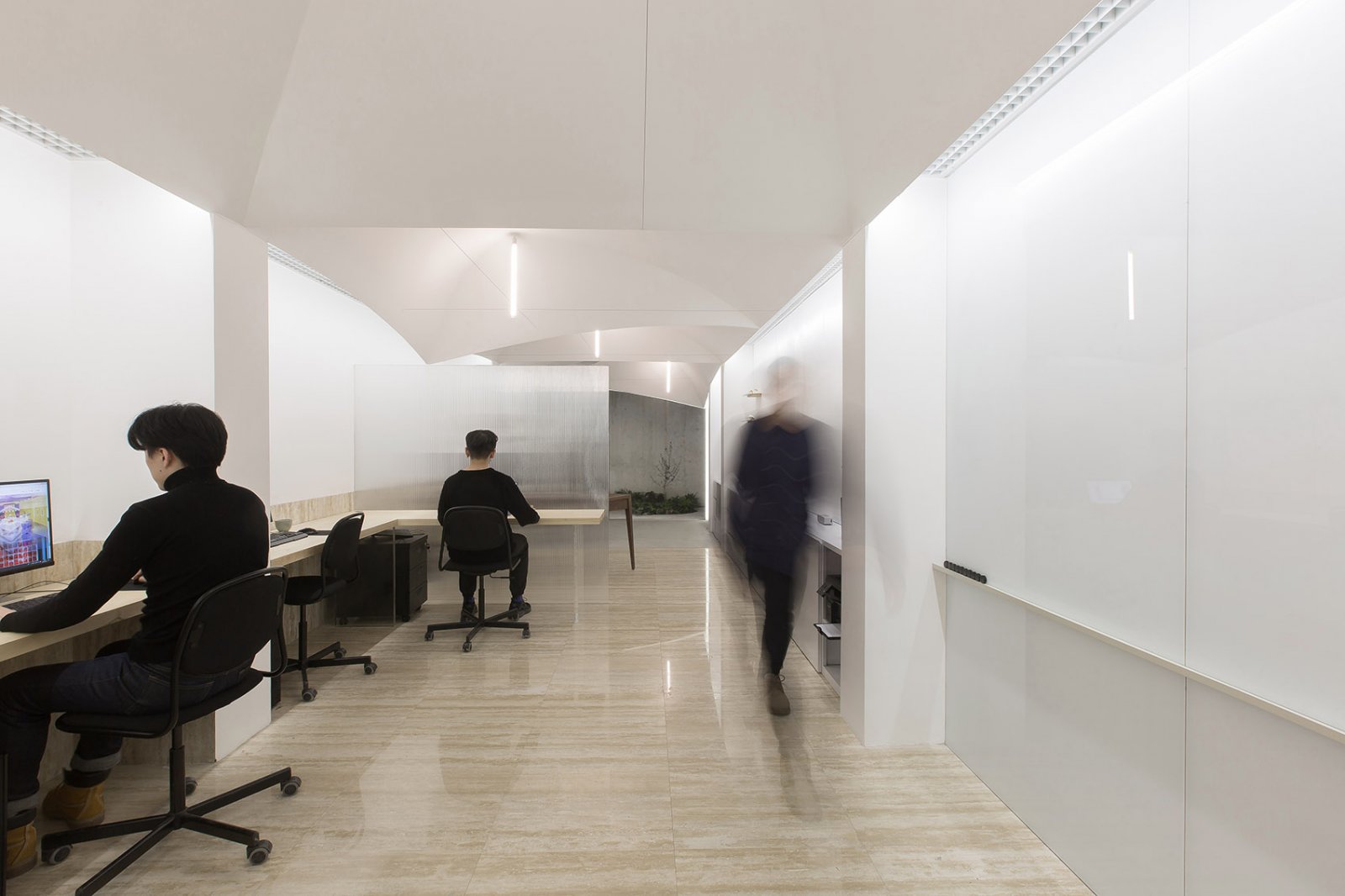Baroque Parking Garage Milan Mijalkovic + PPAG architects
2013-09-15 00:00
架构师提供的文本描述。2010年2月,马其顿共和国住宅和商业地产管理公共企业发起了斯科普里市中心停车场开放式建筑竞赛,将提供315个停车位以及办公和零售空间。根据比赛简报,车库应该设计成“巴洛克,古典,新古典,浪漫和新浪漫风格”(原文如此!)
Text description provided by the architects. In February 2010, the Public Enterprise for Management of Residential and Commercial Properties of the Republic of Macedonia launched an open architectural competition for a parking garage in the city center of Skopje, which should provide 315 parking places as well as space for offices and retail. According to the competition brief, the garage should be designed in a “baroque, classic, neo-classic, romantic and neo-romantic style” (sic!).
这个车库是在“斯科普里2014”(Skopje 2014)框架内预计的几个停车设施之一,这是一个巨大的重组项目,由民粹主义保守政府在2010年提出。南斯拉夫解体近20年后,这一项目正在通过城市化和建筑重新发明和重申马其顿的独立、不可否认和荣耀的民族认同。马其顿文化以大量的纪念物、宗教标志和新的公共建筑来庆祝,这些建筑大多是用历史主义风格设计的。新巴洛克以其权力的内涵和对人民群众的影响而受到人们的喜爱.这些风格的广泛使用被认为是为了将斯科普里确立为它从未真正成为过的欧洲、基督教和资产阶级城市,并否认它的东方、伊斯兰以及社会主义和现代的过去。
This garage is one of several parking facilities which are projected within the frame of “Skopje 2014”, a gigantic restructuring project that was presented by the populist conservative government in 2010. Almost twenty years after the dissolution of Yugoslavia, this project is reinventing and reaffirmating Macedonia´s seperable, undeniable and glorified national identity through urbanism and architecture. Macedonian culture is celebrated by a large number of memorials, religious symbols and new public buildings which are mostly designed in a historicist style. Neo-baroque is the favorite one, with its connotation of power and impact on the masses. The extensive use of these styles is supposed to establish Skopje as the European, Christian, bourgeois city that it has never really been – and to deny its oriental, Islamic as well as it socialist, modern past.
所有这一切都发生在一个50年前被宣布为“开放城市”的城市,它向一个不断变化的社会开放。1963年毁灭性地震之后,在联合国监督下进行的重大国际重建工作被视为使整个城市结构合理化的机会。应该建立一个全新的城市中心,日本建筑师坦格(KenzoTange)负责它的总体规划。社会流动性的提高一直是坦格计划的核心议题之一,因此他提出了一个同心圆和径向轴的循环系统,一个名为“城市门”的交通枢纽,以及“城墙”的高密度楼板砌块住房下的个人停车设施,最初是为30.000名居民规划的。无论如何,停车设施的供应显然不符合当时的需要,它们很快就变成了私人储存空间,特别是附近蔬菜市场的小贩。
All this is happening to a city that fifty years before has been declared an “Open City”, open to a society in flux. Following the devastating earthquake of 1963, a major international reconstruction effort under UN supervision was seen as an opportunity to rationalize the whole structure of the city. A totally new city center should be created, the Japanese architect Kenzo Tange was responsible for its master plan. The increasing mobility of the society has been one core topic of Tange´s plan, therefore he proposed a circulation system of concentric rings and radial axes, a transport hub called “City Gate” as well as facilities for individual parking beneath the high-density slab-block housing of the “City Wall”, originally planned for 30.000 inhabitants. Anyhow, the supply of parking facilities obviously didn´t match the needs of the time and they were soon transformed into private storage space, especially used by vendors of the nearby vegetable markets.
近年来,斯科普里的交通迅速增加,停车场组织得相当广泛。这个城市愿意通过提供更多的多层停车位来解决这个问题。在2010年的车库竞赛中,米兰·米亚科维奇和来自维也纳的PPAG建筑师一起提交了一个项目,巧妙地评论了今天的“斯科普里2014”背景。该项目未能赢得竞争,但由公共企业购买,交给斯科普里市(据报,是通过喜欢该项目的外墙的总理亲自干预)。会议决定,外观应在另一个车库项目内实现,该项目已处于规划阶段,由当地建筑学院的两名教授设计。有几位教授直接或间接地参与了“斯科普里2014”(Skopje 2014)的项目-这或许可以解释他们对这座城市古旧化的相当谨慎的批评。
In recent years, the traffic in Skopje rapidly increased and parking is organized rather wildly. The city is willing to solve the problem by offering additional multi-storey space for parking. In the 2010 competition for the garage, Milan Mijalkovic together with ppag architects from Vienna handed in a project that subtly comments on today´s context of “Skopje 2014”. The project could not win the competition but it was purchased by the Public Enterprise and given to the city of Skopje (reportedly, through a personal intervention of the prime minister who was fond of the project´s façade). It was decided that the façade should be realized within another garage project that was already in the stage of planning and designed by two professors of the local faculty of architecture. There are several professors of the faculty who are – directly or indirectly – involved in the projects of “Skopje 2014” – a fact that might explain their rather cautious critique on the city´s antiquization.
拟议中的外观解释了历史主义出现的愿望,而没有明确地使用传统的历史主义语言。它以虚幻的视角来适应巴洛克式的创造现实的思想。巴洛克艺术作品扩展到真实的空间,反之亦然,现实融入了艺术作品的虚幻视角。立面设计的起点是一张业余摄影,展示了维也纳历史主义住宅的透视图。这些扭曲的外观被放大并组装到一个不清楚的消失点的表面。表面被分解成四层量身定做的、阴影投射在钢结构上的复合板。将历史主义住宅的熟悉外观转变为“巴洛克式车库”的奇怪封面,使这一新事物变得不可思议-“不怀好意”(Unheimlich)。虽然引用不是很明显,但旁观者感觉到了这种不可思议的、梦幻般的-或噩梦般的感觉。这种令人不安的“巴洛克车库”的存在微妙地反映了“斯科普里2014年”令人不安的情况。
The proposed façade interprets the wish for a historicist appearance without explicitly using the traditional language of historicism. It adapts the baroque idea of creating reality by the means of illusive perspective. Baroque artworks expand into the real space as well as vice versa the reality merges into the illusive perspective of the artwork. The starting point for the design of the façade is an amateur´s photograph showing a perspective view of historicist residential houses in Vienna. These distorted façades are multiplied and assembled to a surface of an unclear vanishing point. The surface is dissolved into four layers of tailored, shadow throwing composite panels on a steel construction. Transforming the familiar appearance of historicist residential houses into a strange cover of a “baroque garage” makes this new object uncanny, “unheimlich”. Although the reference is not very obvious, the beholder senses this uncanny, dreamlike – or nightmare like. This disturbing presence of the “baroque garage” subtly reflects the disturbing situation of “Skopje 2014”.
 举报
举报
别默默的看了,快登录帮我评论一下吧!:)
注册
登录
更多评论
相关文章
-

描边风设计中,最容易犯的8种问题分析
2018年走过了四分之一,LOGO设计趋势也清晰了LOGO设计
-

描边风设计中,最容易犯的8种问题分析
2018年走过了四分之一,LOGO设计趋势也清晰了LOGO设计
-

描边风设计中,最容易犯的8种问题分析
2018年走过了四分之一,LOGO设计趋势也清晰了LOGO设计


























































